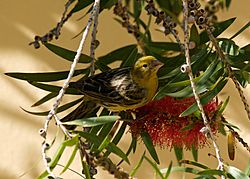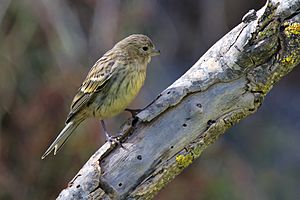Canary facts for kids
Quick facts for kids Canary |
|
|---|---|
 |
|
| Canary (Serinus canaria) | |
| Conservation status | |
| Scientific classification | |
| Kingdom: | |
| Phylum: | |
| Class: | |
| Order: | |
| Family: | |
| Genus: |
Serinus
|
| Species: |
S. canaria
|
| Binomial name | |
| Serinus canaria (Linnaeus, 1758)
|
|
The Canary (Serinus canaria), also known as the Island Canary or Atlantic Canary, is a small passerine bird. It belongs to the finch family. These birds are originally from the Canary Islands, the Azores, and Madeira. Wild Canaries are mostly yellow-green with brownish stripes on their backs.
Canaries are very popular pets and are often kept in homes. Many different colors have been bred over time. For a long time, Canaries were also used in coal mines. Miners would take a Canary in a cage underground. If the bird got sick or died, it meant there was too much dangerous carbon monoxide gas. This warned the miners to leave quickly.
Contents
About Canaries
Canaries are small birds, usually about 10 to 12 centimeters (4 to 5 inches) long. Their wings can spread about 21 to 24 centimeters (8 to 9 inches) wide. They weigh around 8 to 24 grams (0.3 to 0.8 ounces).
Male Canaries have a yellow-green head and belly. Their forehead and face are often brighter yellow. Females look similar but are usually duller in color. Young Canaries are mostly brown with dark stripes.
Canaries are a bit larger than their relative, the European serin. They have more gray and brown feathers. Their wings are also a bit shorter.
Canary Sounds
The song of a Canary is a pretty, silvery sound. It is similar to the songs of other finches like the European serin.
Where the Name Comes From
The Canary bird is named after the Canary Islands. The islands themselves were named after dogs (canis is Latin for dog). The bright color "canary yellow" is named after the yellow pet Canary. This yellow color came from a natural change in the bird's genes.
Where Canaries Live

Wild Canaries live on islands in the eastern Atlantic Ocean. These islands include the Canary Islands, the Azores, and Madeira. This area is known as Macaronesia.
In the Canary Islands, they are common on Tenerife, La Gomera, La Palma, and El Hierro. They are less common on Gran Canaria, Lanzarote, and Fuerteventura. Canaries are also common in Madeira and the Azores.
Many Canaries live in different places, from pine forests to sand dunes. They like open areas with small trees, like orchards or gardens. You can find them from sea level up to high mountains.
Canaries have also been taken to other parts of the world. They were brought to Midway Atoll in the Hawaiian Islands in 1911. Some were also introduced to Bermuda in 1930. However, they later died out there due to problems with their food source.
How Canaries Behave
Making a Home
Canaries are social birds and often nest in groups. Each pair protects a small area around their nest. They build a cup-shaped nest in a tree or bush. The nest is usually 1 to 6 meters (3 to 20 feet) off the ground. It is often hidden among leaves.
They build their nests from twigs, grass, and moss. They line it with soft materials like hair and feathers.
Eggs and Young
Canaries lay their eggs between January and July, depending on the island. The eggs are pale blue or blue-green. They often have purple or reddish marks. A female Canary usually lays 3 to 4 eggs. They can raise 2 or 3 groups of young birds each year.
The eggs hatch after about 13 to 14 days. The young birds leave the nest when they are about 14 to 21 days old.
What Canaries Eat
Canaries usually feed in groups. They look for food on the ground or in low plants. They mainly eat seeds from weeds and grasses. They also eat other plant parts and small insects.



